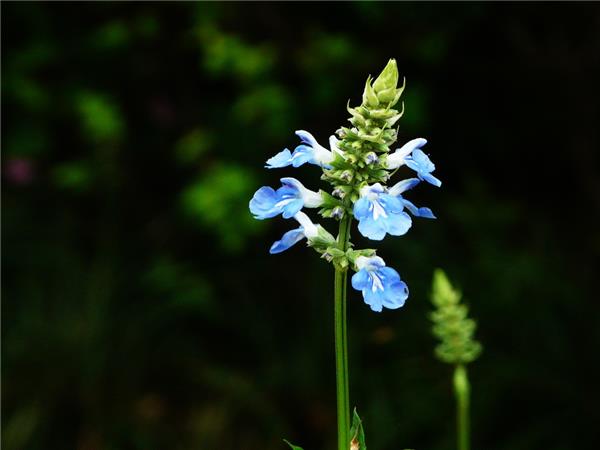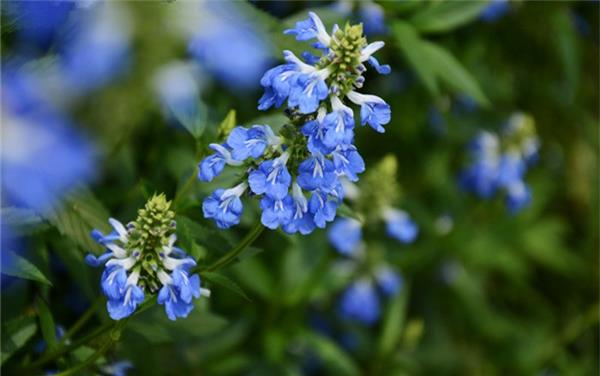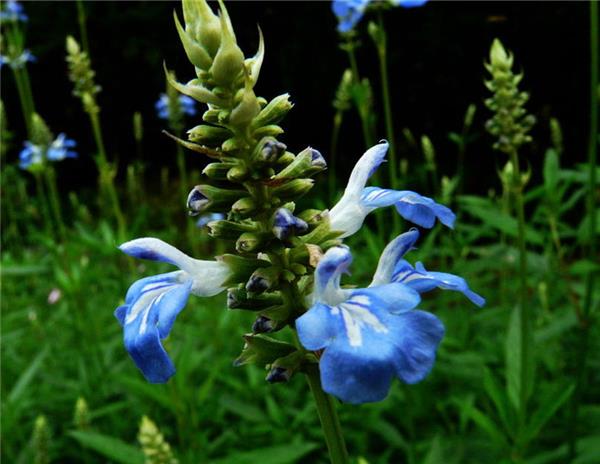The effect of sage how to raise Salvia officinalis
The flower pattern of sage is a small string of flowers gathered together, giving people a lovely and charming feeling. Although this kind of flower is small, its function is not small, so it is very suitable for breeding.

What is Sky Blue Salvia
Sage, perennial root herb; sky blue flowers, flowering plants up to 1.5 meters high, flowering in spring; like warm, sunny environment, do not choose soil, drought tolerance, but not waterlogging, especially like limestone-rich, or sandy, well-drained soil, annual cultivation in extremely cold areas. Sage in early Europe is a magical plant with many effects; it is not only an excellent ornamental plant, but also an important medicinal plant. It is suitable for making background material of flower border. Flowers can be used to make tea, send out a clear fragrance can purify the body oil, help circulation, can play the effect of beauty.

Second, the function and efficacy of sage.
1. Sage is one of the very good materials of traditional Chinese medicine, which has an unexpected effect on the treatment of returning milk during weaning period. it can also be used as a bitter stomach medicine, which plays an important role in expelling wind, inhibiting sweating, lowering blood sugar and promoting bile secretion.
two。 Sage brewed when tea, vanilla flavor with a little spicy, bitter taste, can add some honey seasoning, is a good choice for health drinks, but also not suitable for long-term drinking.
3. Soak the branches, leaves or flowers of fresh sage in water and can be used as disinfectant.
4. Dried flowers can be used as bacon spices or dried flower works of art.
5. Although the sky blue sage has many health care functions, it contains some ingredients that will produce toxins in the human body after drinking in large quantities for a long time. In addition, pregnant women during lactation are forbidden to drink, because it will affect the secretion of milk, so lovers should not be careless.

3. Culture methods and matters needing attention of sage.
1. Selection and treatment of cuttings: branches with strong growth and no diseases and insect pests should be selected as cuttings. After selecting the cuttings, you should handle them carefully. Cuttings of twigs should be cut immediately after harvest to prevent wilting from affecting survival. After cutting, you should leave it in a ventilated place to dry for a few days, wait for the incision to shrink slightly and then insert it, or barbecue the lower incision with a slight fire to prevent decay. In general, the lower cut of plant cuttings, such as some freshly burned plant ash, also has the effect of preventing decay.
two。 Soil: the cultivation medium is loose and permeable, good water retention, moderate pH, small nutrient content, no disease, generally choose fine-grained peat, peat or rotten leaf soil.
3. Temperature: general plant cuttings to keep 20: 25 ℃ C rooting the fastest. If the temperature is too low, the rooting is slow, and if the temperature is too high, it is easy to cause the cutting incision to rot. Therefore, if the temperature is artificially controlled, it can be inserted all the year round. Under natural conditions, the temperature in spring and autumn is suitable.
4. Humidity: after insertion, we should pay attention to keep the substrate moist, but do not make it too wet, otherwise it will cause decay. At the same time, we should also pay attention to the humidity of the air, can be covered with plastic film to maintain humidity, but should pay attention to ventilation in a certain period of time.
5. Florescence: the flowering time of sage can be controlled by sowing time and planting time. In general, it takes about 60 days from sowing to flowering, and the sowing time can be adjusted according to the needs. You can also determine the specific insertion time according to the need, from January to February for spring flower beds, and from May to June for summer and autumn flower beds.

Finally, I would like to remind everyone again that when raising sage, try not to let children come into contact with it, because it may cause danger such as poisoning caused by eating too much, so when raising sage, you must pay attention to good protective measures, and pay attention to careful handling and proper consumption when eating.
Related
- Wuhan Hospital Iron Tree Blooming Result Was Instantly Frightened by the Gardener Master
- Which variety of camellia is the most fragrant and best? Which one do you like best?
- What is the small blue coat, the breeding methods and matters needing attention of the succulent plant
- Dormancy time and maintenance management of succulent plants during dormancy
- Minas succulent how to raise, Minas succulent plant pictures
- What are the varieties of winter succulent plants
- How to raise succulent plants in twelve rolls? let's take a look at some experience of breeding twelve rolls.
- Attention should be paid to water control for succulent plants during dormant period (winter and summer)
- Watering experience of twelve rolls of succulent plants
- Techniques for fertilizing succulent plants. An article will let you know how to fertilize succulent plants.



